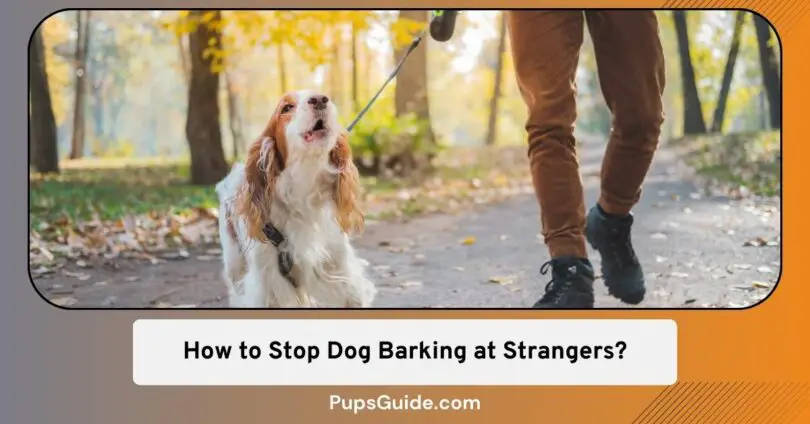Dogs often give those barks out of fear when they meet someone new. It’s like their internal alarm system going off, signalling potential danger. This sets off a “fight or flight” response in them, thanks to some chemicals in their body.
Imagine you’re at home with your kids, and an unexpected guest shows up in your living room. You might want to yell and scream, just like a dog barking.
But think about what would make you feel better in that situation: someone charging in like a bulldozer, or someone calmly explaining they mean no harm? Dogs need to learn that strangers can be friends, not foes.
You see, crating your dog when strangers come around can actually make things worse. It’s like locking your dog’s anxiety in a tiny box, which is no fun for them. And if you try to force them into the crate, it’s a recipe for more anxiety, reinforcing the idea that strangers are scary and barking is the way to go.
If you want to stop your dog from going all Cujo on strangers, you need to change how you react when they show up.
Remember, most dogs like, yorkies, etc bark for a reason, so they won’t just be silent. But with some training and patience, you can teach them that strangers aren’t worth the barking and that there are better ways to handle their nerves.
Now, let’s talk about how to train your pup to be the cool, calm, and collected canine you want when new folks come a-knocking.
How Can I Train my Dog Not to Bark and Growl at Strangers?
Follow my own crafted 6-step regime for an efficient break from all the howling, growling, and whatnot.
Step 1: Create Some Space
The first step in this training process is to invite the stranger into your home or yard while your dog watches from a distance to ensure your dog feels safe while getting used to the new person’s presence.
Gradual Exposure
By gradually getting your dog accustomed to the stranger’s presence, you create an environment where your furry friend can observe without feeling threatened.
This distance-based approach lays the foundation for the following steps, building the confidence needed to reduce excessive barking.
Step 2: Boost Your Dog’s Confidence
Now that you’ve established a safe distance between your dog and the stranger, it’s time to bridge the gap between fear and trust.
The key to success lies in helping your dog associate strangers with positivity. Here’s how to boost your dog’s confidence:
Positive Reinforcement
One of the most effective ways to build trust and reduce fear is by having the stranger offer treats to your dog from a distance.
Treats represent rewards, and rewards create positive associations. When your dog gets treats from the stranger, they’ll start to link the stranger’s presence with good things.
Respecting Comfort Zones
It’s essential to pay attention to your dog’s body language. Make sure your dog feels safe and comfortable during this process.
Avoid pushing your dog beyond their comfort zone, as that could have the opposite effect and increase fear rather than reduce it.
Step 3: No Staring – Less Scary
In our journey to help your dog feel at ease around strangers, we reach a crucial step: avoiding direct eye contact.
Dogs are highly attuned to body language, and eye contact can be seen as a challenge or threat. Here’s how to navigate this crucial phase:
Why Eye Contact Matters?
Direct eye contact is a powerful form of communication among humans. However, in the canine world, it can signify dominance, aggression, or confrontation.
When a stranger avoids eye contact with your dog, it immediately reduces the potential for intimidation.
Turning Their Back
To help your dog relax and feel less threatened, have the stranger turn their back or look away when interacting.
This simple adjustment to their body language can make a world of difference in how your dog perceives them. It conveys a non-threatening demeanor, allowing your dog to let their guard down.
Building Trust Through Comfort
By avoiding direct eye contact, the stranger contributes to a calming environment, which is essential for your dog’s gradual adaptation.
Your dog should feel that the presence of a stranger is not a cause for concern but an opportunity for positive interaction.
Creating Healthy Boundaries
Remember that respecting your dog’s comfort and boundaries is of paramount importance. The goal is to build trust, not to force interactions.
The no-eye-contact approach is a key element in this journey toward a more relaxed and confident canine companion.
Step 4: Reward and Slowly Approach – Building Confidence
With each step of this training process, you’re moving closer to helping your dog feel at ease around strangers.
As your dog becomes more comfortable with the stranger’s presence, it’s time to reward their progress and gradually reduce the distance between them.
Here’s how to reinforce the idea that strangers are not a threat but potential sources of rewards:
Reducing the Gap
Once your dog shows signs of increased comfort with the stranger, you can begin to reduce the physical distance between them.
Positive Reinforcement
Reward your dog’s positive strides with treats and praise. By doing this, you create a strong positive association between the stranger’s presence and rewards.
Doing this reinforces the idea that strangers are not only non-threatening but can also bring pleasant surprises.
Reinforcing Confidence
Rewarding your dog not only celebrates their progress but also boosts their confidence.
Your dog will start to anticipate positive experiences when strangers are around, leading to a more relaxed and friendly attitude toward newcomers.
Step 5: Be Patient and Take Breaks – The Importance of Patience
Alright, let’s talk about the fifth step: Patience and Break Time. Training your dog to chill out around strangers and stop that barking habit requires a big dose of patience.
Trying to rush things will just stress you and your furry buddy out. So, why is patience so important, and why should you take breaks during your training sessions?
Understanding the Process
It’s crucial to know that your dog’s journey from being scared to being comfortable around strangers is a slow one.
Every dog has their own speed, and if you push too hard too fast, it can lead to setbacks. Expect baby steps forward and sometimes a step back or two.
The Power of Breaks
Taking breaks isn’t just about catching your breath. They’re crucial for your dog’s well-being during training.
When your pup steps back and chills, it helps them process the new experiences and prevents them from getting overwhelmed.
Stress-Free Environment
Creating a stress-free environment is key to successful training. When your dog is relaxed and at ease, they’re more likely to start thinking of strangers as buddies.
Taking breaks helps keep this positive vibe going.
Step 6: Progress at Your Dog’s Pace – Honoring Individual Differences
Dogs, like people, come in all shapes and sizes, with their own quirks and personalities.
Some may quickly adapt to new situations, while others need more time and patience. As you work on getting your dog to stop barking at strangers, it’s crucial to understand and appreciate the unique behaviors in our furry friends.
Respect Their Timing
Remember, every dog has their own schedule for feeling comfy around strangers. It’s all about their personality, past experiences, and their natural disposition.
Be patient and respect your dog’s personal timeline. Don’t compare their progress to other dogs.
Different Reactions
Some dogs may make big leaps in a short time, while others might need more time to trust new faces.
Your dog’s behavior can change during training, so expect ups and downs along the way.
Adjust Your Expectations
Even though we all wish for a quick fix to our dog’s barking, the real goal is lasting, long-term progress. So, respect your dog’s pace instead of rushing things.
Reading Their Signals
Dogs speak their own language through body cues, barks, and actions. You need to be a keen and understanding trainer, listening to your dog’s signals and responding appropriately.
Personalized Training
Realize that there’s no one-size-fits-all approach to training your dog. What works for one dog might not work for another. Tailoring your training methods to your dog’s unique needs is the best way to get lasting results.
Bonus Tip: Leash Up Reactive Dogs – Ensuring Safety and Control
Some dogs have a stronger reaction to strangers, with behaviors like lunging or even nipping along with barking.
If your dog is one of them, you need to be extra cautious during training to keep things safe and under control.
The Leash’s Role
Having your dog on a leash during training is like adding a seatbelt.
It helps you steer your dog, redirect their attention, and prevent unexpected encounters with strangers. When your dog is reactive, the leash becomes your essential tool for managing their behavior.
Training with a Leash
With a leash, you can guide your dog, shift their focus, and stop impulsive reactions more easily.
This added control makes the environment safer for both your dog and the stranger. Plus, it lets the stranger know that your dog is in training mode.
Consulting a Pro
For super reactive dogs, getting help from a pro dog trainer who uses positive methods can make a big difference.
They can give expert advice, tailored strategies, and hands-on training to tackle your dog’s specific issues with strangers.
Patience and Dedication
Remember, training your dog to stop barking at strangers is a journey that needs your patience and commitment. Each dog is unique, so progress may vary. By following these steps and taking extra measures, like leashing up reactive dogs, you’ll create a safe and productive training atmosphere.
What is a 3-Bark Rule? An Alternative Training Method
As you’re reading this, keep in mind that every dog has their own way of doing things. You might want to give this alternative training method a shot alongside the one I told you about earlier.
So, this “three bark rule” is a trick folks use to handle alert barking in dogs when they get all worked up over something they see, like a passerby or a squirrel outside.
The idea is to interrupt the barking and get your pup back to you so you can give ’em a treat and then go back to what you were doing.
Here’s the lowdown:
1. Get a Cue Word:
Start by teaching your dog a special word or phrase, like “quiet” or “that’s enough,” to let them know it’s time to stop barking and come to you. The cue word should be something your dog understands as a signal to stop barking.
2. Offer a Treat:
You need a tasty reward to give your dog when they follow the cue. It can be treats if your dog’s into food, a toy, or whatever gets their tail wagging.
3. Steps to Train:
- First off, practice the cue word when your dog’s being quiet, not when they’re in full bark mode.
- Use the cue word, and when your dog comes to you, give them treats or the chosen motivator.
- Repeat this a bunch to link the cue word with a good reward when the dog is quiet.
4. Use It with Alert Barking:
Once your dog gets the cue word and its meaning, you can start using it when they’re alert barking.
When your dog starts barking at something, use the cue word to get their attention, and then lure or encourage them to come to you with the motivator.
5. Reward and Let Go:
When your dog comes to you and stops barking, reward them right away with treats or their motivator. After rewarding, they can go back to their business.
6. Keep Practicing:
Keep at it to make sure this behavior sticks. Over time, you might not need to bribe your dog with treats because they’ll get the cue and come to you on their own.
This method helps manage that alert barking, making outings and adventures with your dog more fun, ’cause you can keep their barking in check and steer their attention when needed.
Just remember to stay positive and be patient during the training to help your dog catch on.
Will my dog outgrow barking at strangers?
Barking at strangers is something lots of dogs do, especially as they grow up and start noticing the world around them.
It’s just part of their nature to be protective and watchful when they come across new people or situations. Here’s what you can expect:
1. Age and Growing Up
At around 8-12 months old, dogs usually start becoming more aware of their surroundings and might begin barking at strangers.
This is part of their natural development as they leave their puppy days behind.
2. Learning from the Pack
If your dog isn’t naturally a barker, hanging out with other dogs who are good at it can influence them.
Dogs often pick up habits from their furry friends, and they might start barking at strangers by copying what they’ve seen.
3. Attention-Grabbing Phase
Puppies all go through a phase where they need more attention and can get anxious when they’re alone. This can lead to barking as a way to get noticed and express their feelings.
So, it’s important to establish a steady routine and provide socialization during this stage to help them grow into well-adjusted adults.
4. How Do You React to Barking?
How you deal with your barking pup can affect whether this behavior becomes a habit.
If you consistently give in to their barking with attention or rewards, they might figure out that barking is a great way to get what they want.
That’s where the training methods I talked about come in handy.
Should You Give Your Dog a Good Scolding for Barking at Strangers?
Well, scolding your furry friend for barking might not be the most effective approach. Here’s why:
1. Avoid Scolding for Attention
If your dog’s barking because they want attention and you scold them, you’re still giving them attention, which might make them think their barking is working.
Instead, try redirecting them to better activities or behaviors to meet their needs.
2. Dig Deeper for the Cause
Barking is often just a sign of an underlying issue, like boredom or anxiety. It’s essential to figure out what’s really bothering your dog and deal with that problem.
Consider more training sessions, mental challenges, or puzzle games to keep them busy.
3. Dogs Don’t Get It
Dogs don’t really understand that their actions are meant to annoy you or that you’re scolding them.
It’s better to focus on addressing the root cause of their barking rather than punishing them for it.
This way, you can build a better bond with your dog based on positive reinforcement and proper behavior training.
Read Here: Shock Collars and Bark Collars
How To Stop Dog Barking At Strangers? Conclusion
Managing your dog’s barking at strangers requires patience, understanding, and a well-thought-out approach.
Dogs bark at newcomers primarily out of fear, and it’s our responsibility to help them overcome this anxiety. Rather than resorting to scolding, which can be counterproductive, it’s more effective to employ positive training techniques.
The 6-step training regimen that I outlined earlier is a comprehensive guide to gradually adjusting your dog to strangers and building their confidence.
Additionally, the “three bark rule” is an alternative method to manage alert barking, helping your dog learn to respond to a cue word and redirect their attention without scolding.
While barking at strangers is a common behavior, dogs can indeed outgrow it as they mature and receive proper training and socialization.
By focusing on positive reinforcement and patient guidance, you can strengthen your bond with your furry friend and help them become a well-adjusted, confident companion.
Good Luck🤞!








Leave a Comment